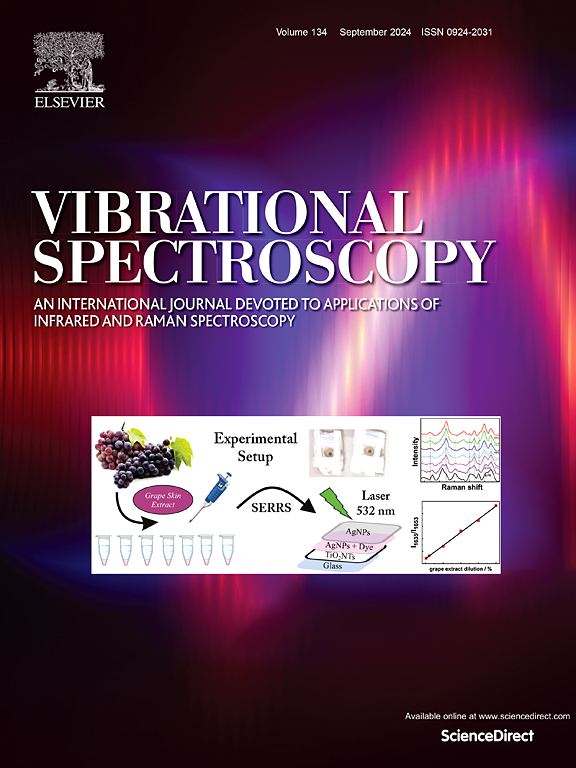利用银和金表面的SERS研究人类唾液中温度依赖的光谱变化
IF 3.1
3区 化学
Q2 CHEMISTRY, ANALYTICAL
引用次数: 0
摘要
表面增强拉曼散射(SERS)光谱,结合多元数据分析,如主成分分析(PCA),有效地检测复杂生物样品的细微变化。在本研究中,我们应用SERS识别了沉积在大型纳米结构Ag和Au底物上的人唾液中的细微分子变化,重点研究了温度变化(10°C至45°C)的影响。所选择的温度区间——10°C(冷却技术)、23°C(实验室温度)、37°C(生理温度)、42°C(发热)和45°C(极端温度)——反映了生物和医学样本在收集、储存、运输和分析过程中可能遇到的现实条件。我们的目的是确定唾液样本是否在这些温度下保持稳定超过四天,或者是否发生重大变化。此外,我们研究了热跳跃期间光谱变化的可逆性,其中样品加热到45°C,然后冷却回10°C。为了确保可靠性,我们使用了计算机控制的测绘平台和恒温样品支架,允许精确的温度控制和在基板上的相同位置重复记录。学者注意到强度的变化标志乐队,包括带比率,如1175年的比率 厘米⁻¹ 1005 厘米⁻¹ 乐队(蛋白质水合标记),856年的比率 厘米⁻¹ 831 厘米⁻¹ 乐队(疏水性环境周围的酪氨酸的标志),以及1360年的比率 厘米⁻¹ 1340 厘米⁻¹ 乐队(疏水性标记周围环境的色氨酸)在不同的温度下。随着温度的升高,蛋白质水化标志逐渐降低,表明水分从蛋白质环境中流失。相比之下,酪氨酸和色氨酸残基的疏水性标记呈增加趋势,表明sers活性表面的疏水性增强和蛋白质结构的温度依赖性重组。除了这些标记外,我们还在稳定性测试和热循环过程中监测了每个温度下氨基酸残基带的变化。光谱变化与纳米结构等离子体表面附近的水分流失和分子重组有关,表明唾液对温度条件的敏感性。我们的研究结果强调了在大面积衬底上保持唾液膜的适当储存条件的重要性,以保持样品的完整性并防止对温度引起的光谱变化的误解。本研究有助于热敏材料,特别是生物流体的SERS分析的最佳实践,特别是在医疗诊断的背景下。本文章由计算机程序翻译,如有差异,请以英文原文为准。
Investigating temperature-dependent spectral changes in human saliva using SERS on Ag and Au surfaces
Surface-enhanced Raman Scattering (SERS) Spectroscopy, combined with multivariate data analysis such as Principal Component Analysis (PCA), effectively detects subtle changes in complex biological samples. In this study, we applied SERS to identify subtle molecular changes in human saliva deposited on large nanostructured Ag and Au substrates, focusing on the influence of temperature variations ranging from 10°C to 45°C. The selected temperature intervals – 10°C (cooling technology), 23°C (laboratory temperature), 37°C (physiological temperature), 42°C (fever), and 45°C (extreme temperatures) – reflect real-world conditions that biological and medical samples may encounter during collection, storage, transport, and analysis. We aimed to determine whether saliva samples remain stable at these temperatures over four days or if significant changes occur. Furthermore, we investigated the reversibility of spectral alterations during thermal jumps, where samples were heated to 45°C and then cooled back to 10°C. To ensure reliability, we utilized a computer-controlled mapping stage and a thermostatic sample holder, allowing precise temperature control and repeated recordings at identical locations on the substrate. Attention was given to intensity changes of marker bands, including band ratios, such as the ratio of 1175 cm⁻¹ to 1005 cm⁻¹ bands (protein hydration marker), the ratio of 856 cm⁻¹ to 831 cm⁻¹ bands (hydrophobicity marker of the environment surrounding tyrosine), and the ratio of 1360 cm⁻¹ to 1340 cm⁻¹ bands (hydrophobicity marker of the environment surrounding tryptophan) at different temperatures. The protein hydration marker exhibited a progressive decrease with increasing temperature, indicating water loss from the protein environment. In contrast, the hydrophobicity markers for tyrosine and tryptophan residues showed an increasing trend, suggesting enhanced hydrophobicity and a temperature-dependent reorganization of the protein structure on the SERS-active surfaces. In addition to these markers, we monitored changes related to amino acid residue bands for each temperature during the stability tests and thermal cycling. The spectral changes were associated with water loss and the reorganization of molecules near the nanostructured plasmonic surface, indicating saliva's sensitivity to temperature conditions. Our findings emphasize the importance of maintaining proper storage conditions for saliva films on large-area substrates to preserve sample integrity and prevent the misinterpretation of temperature-induced spectral changes. This study contributes to best practices for SERS analysis of thermally sensitive materials, particularly biofluids, especially in the context of medical diagnostics.
求助全文
通过发布文献求助,成功后即可免费获取论文全文。
去求助
来源期刊

Vibrational Spectroscopy
化学-分析化学
CiteScore
4.70
自引率
4.00%
发文量
103
审稿时长
52 days
期刊介绍:
Vibrational Spectroscopy provides a vehicle for the publication of original research that focuses on vibrational spectroscopy. This covers infrared, near-infrared and Raman spectroscopies and publishes papers dealing with developments in applications, theory, techniques and instrumentation.
The topics covered by the journal include:
Sampling techniques,
Vibrational spectroscopy coupled with separation techniques,
Instrumentation (Fourier transform, conventional and laser based),
Data manipulation,
Spectra-structure correlation and group frequencies.
The application areas covered include:
Analytical chemistry,
Bio-organic and bio-inorganic chemistry,
Organic chemistry,
Inorganic chemistry,
Catalysis,
Environmental science,
Industrial chemistry,
Materials science,
Physical chemistry,
Polymer science,
Process control,
Specialized problem solving.
 求助内容:
求助内容: 应助结果提醒方式:
应助结果提醒方式:


